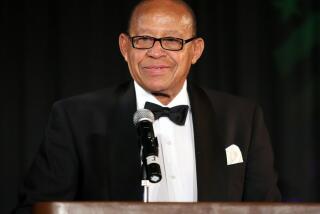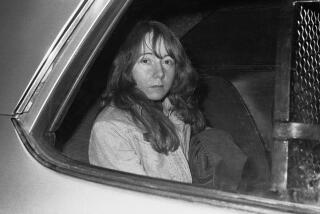JFK assassination reporter recalls Zapruder saying, ‘I know he’s dead’
Darwin Payne, 76, of Dallas, was among the crowd of reporters dispatched to cover the aftermath of the assassination of President John F. Kennedy.
Now a professor emeritus of communications at Southern Methodist University in Dallas, Payne discussed his memories of that day with the Los Angeles Times. He recounted the tense atmosphere surrounding Kennedy’s visit, seeing Lee Harvey Oswald and interviewing Abraham Zapruder, who with his home movie camera captured the fatal shot.
What did you think of Kennedy before he came to Dallas?
My first vote for president was for Kennedy, 1960. So, I admired him a great deal. My family did — just about everybody I knew did. Most reporters were liberal in their political outlook and so all my fellow reporters thought very highly of the president and anticipated his arrival.
But Dallas was a conservative city at the time, and Kennedy was not popular there, right?
The political climate in Dallas, in part, was an exception to the other Texas cities and was pretty hostile to Kennedy — [in] Dallas most people had not supported him in the ’60 election.
Dallas had attracted a lot of extremist right-wing elements. It had people like Edwin A. Walker, the major general in the U.S. Army who had given up his appointment when he was accused of indoctrinating his troops with John Birch Society materials; he chose to come to Dallas and attracted a lot of attention.
H.L. Hunt, the famous oil man and millionaire, was politicizing with leaflets and paperback books, all extremist right-wing documents. The Dallas Morning News [was] a very right-wing, reactionary newspaper. The pastor of First Baptist Church, W.A. Criswell, had said during the political campaign that if a Catholic was elected president, it would mean the end of religious freedom in America.
How did the city’s leaders handle that before Kennedy arrived?
Of the cities Kennedy was coming to, Dallas was the only city that had leaders that urged him not to come. They were fearful for what might happen. Not necessarily that he would be injured in any way, but that he would be pestered and bothered...
I was present at that [U.N. Ambassador] Adlai Stevenson event at Memorial Auditorium downtown [a month earlier] and it was quite disgraceful. He, of course, was shouted down by hecklers in his speech and afterward hit on the head with a picket sign and spat upon. That attracted national attention, it was on television, and people wondered what in the world is going on in Dallas, just as they had wondered in 1960 when LBJ and Lady Bird were assaulted at the Adolphus Hotel by an antagonistic crowd.
The mayor, the city manager, the sheriff — they were urging people to be calm, to treat the president with respect.
The day of Kennedy’s arrival, you were new at the Dallas Times Herald and initially assigned to stay in the office and handle rewrite for a story about Jacqueline Kennedy. How did you feel about that?
I was a bit disappointed — I would have liked to have been out to see Kennedy at some point, but somebody had to do rewriting. It was an afternoon newspaper and we were right on deadline when he arrived. So my job was to do the story on Jackie. We had two reporters assigned out in the field to see what she was saying, doing, what she was wearing, how the crowd was treating her. One was at Love Field, the other was at the Trade Mart [where the Kennedys were scheduled to attend a luncheon].
The Love Field correspondent had already phoned in her notes to me, and I was working on the story about Jackie. I remember her description of the suit that she was wearing with the pink and some black. And I was struggling on that story when the city editor had heard something happened at Dealey Plaza right at the school book depository. He sort of shouted, “He’s been hit!” and I asked, “What with?” I thought maybe a sign, a picket sign.
After the shooting, the city editor sent you and another reporter to Dealey Plaza. What did you find?
There we found a lot of eyewitnesses, of course. And we worked individually, asking people what they had seen — had they heard shots, where did they come from — and talking to police officers and detectives who were around. They were very busy because by the time we got there, they thought the assassin or assassins plural were up in the sixth floor in the school book depository even then. They hadn’t apprehended them. There were officers walking around with rifles, pistols, a fire truck was even on the scene. I expected that we might see a shootout.
How did the eyewitnesses react?
All the people were distraught, emotionally upset at what they had seen. The consensus was three shots had been fired .… Then I encountered, must have been two or three women who worked with Abraham Zapruder. They told me as they answered my questions of what they had seen, “Our boss took pictures of it, moving pictures.” Of course I was very interested in that so I said, “Well, where is he?”
Zapruder’s 8-millimeter film of the assassination later became famous. What did you see when you met him in his office?
He was willing to talk. He had his 8-millimeter camera up on a filing cabinet in the same room and had a television set in that office. We watched the television set and heard Walter Cronkite talking about what he had found out from correspondents and he said that Kennedy had been wounded, perhaps seriously, perhaps fatally and he was at Parkland Hospital. And Abraham Zapruder, who was often in tears when I was there, he said, “No, no, he’s dead, I know he’s dead, I was looking through the viewfinder and I saw his head explode like a firecracker.”
You were trying to get the film. What happened?
We got [Times Herald President James F.] Chambers on the line so I could tell him about the film and see if he wanted to send a Times Herald car down, tell [Zapruder] he would be taken care of, the film was in safe hands.
Zapruder did not want to do that. He wanted to turn the film over to the FBI or Secret Service. Finally, after a while, FBI and Secret Service agents did show up and they took him and the film and departed the scene.
What were you thinking as you looked out of Zapruder’s window before you left?
I realized, gosh, this was a president that I voted for, I admired him. And it’s a good thing that I’m being busy today, otherwise I’d be mired in grief and not know what to do. I thought the fact that I was active and trying to do things, trying to cover it, was good for my mental health.
You went from there to see Lee Harvey Oswald’s “sniper’s nest” in the Texas Schoolbook Depository, then to the rooming house where he stayed in the Oak Cliff neighborhood. What was that like?
They showed us the spot where he had thrown the rifle when he went out …. We peered out the window one at a time.
That’s when we heard that a police officer had been shot in Oak Cliff.
It was getting to be twilight then, and there were quite a number of reporters there. They were in the room talking to the landlady and tenants who had rooms there .… They all had pretty good information. They didn’t know him as Lee Harvey Oswald, they knew him as O.H. Lee, which was the name he had used when he rented a room there about six weeks ago. The landlady, Earlene Roberts, told me yes, she had seen him come in shortly after noon. She told him, “My, you sure are in a hurry!” She said he didn’t say anything, went to his little room off to the side of the living room, picked up his gray coat and he left. He also picked up a pistol.
The next day you covered the scene where police led Oswald out. What was that like?
When I got there, all the newsmen, more than a hundred, some have estimated more than 300, were there in the police station .… I thought I might be asked for identification when I went in the building, but no, I wasn’t, I just caught the elevator, went up to the third floor and saw this huge crowd .…
There were so many people up on that third floor, even a young guy in a sailor’s uniform. I thought, “My, what in the world is he doing here?” So there was no real security up there.
Turns out the police chief and the city manager had determined that they would open this up to reporters as it usually was open to all these reporters because the world should know, the nation should know, that they had in custody the man who was obviously the assassin of the president — that they were interrogating him, that he hadn’t been beaten, and that they wanted to have an open communication.
Did you hear Oswald say anything?
I got a glimpse of him, and you could hear him say, which has been quoted, “All I need is a shower.”
What was the scene like?
When Chief [Jesse] Curry was out giving one of the press conferences it was so congested that one reporter had a notepad propped on the chief’s back, taking his notes …. It was quite a madhouse.
What has stuck with you about that time?
It was very shocking to know, and this is a realization that we’ve all had, that an individual, a tiny little person like Lee Harvey Oswald, could change the course of history with one demonic act.
What do you think the lasting effect was?
The sense of disillusionment occurred, the fact that things weren’t always OK and that the establishment did not have the answers for everything because they could be upset so easily by an individual like Oswald.
What did America lose that day?
Its youthful outlook, its optimism about the future, its hopes that things would be much better in the future. I think all that disappeared and that accounts to a certain degree for all the disruptions that we had that gave impetus to the civil rights movement, people striving to get their just place in society.
More to Read
Sign up for Essential California
The most important California stories and recommendations in your inbox every morning.
You may occasionally receive promotional content from the Los Angeles Times.












